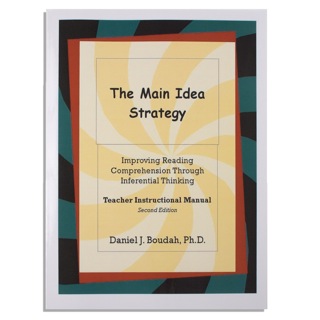Description
Research on the Fundamentals of the Sentence Writing Strategy Program
Study 1
Overview
This study focused on the instruction of several writing strategies in five fifth-grade inclusive general education classes in urban schools where a large proportion of students were living in poverty. Students in three participating classes served as the experimental group whereas students in the two other classes served as the comparison group. A total of 113 students participated, and 14 students with LD were enrolled in the classes. The three classes of experimental students were taught to use the Sentence Writing Strategy, plus adaptations of the Paragraph Writing Strategy and the Theme Writing Strategy. The Fundamentals of the Sentence Writing Strategy program was used for the sentence writing instruction, and a researcher provided the instruction. The comparison students participated in the district’s chosen writing curriculum for the same amount of instructional time and were taught by their regularly assigned teachers.
Results
There were no differences between the experimental and comparison groups on the pretest, which required the students to write an essay. Four major measures were derived from this test including the percentage of complete sentences and the percentage of complicated sentences (i.e., the percentage of sentences that were compound, complex, or compound-complex sentences).
Experimental students as a whole group earned significantly higher scores on the posttest than the pretest on the majority of the writing measures, whereas the comparison students did not. For example, separate ANOVAs revealed significant differences between the experimental students’ pretest and posttest complete sentence scores in favor of the posttest [F (1, 57) = 89, p < .001, η2 = .610], representing a large effect size. Significant differences were also found for the experimental students between the pretest and posttest on the complicated sentences score [F (1, 57) = 61.3, p < .001, η2 = .518], also representing a large effect size.
For the experimental students with LD, separate ANOVAs revealed significant differences between the pretest and posttest complete sentences scores [F(1, 8) = 32, p = .001, η2 = .8] and complicated sentences scores [F(1, 8) = 19.57, p = .002, η2 = .710], with both of these differences representing large effect sizes.
The mean score of the whole group of experimental students on the state competency exam was within the “Proficient” range (i.e., a passing score), whereas the mean score for the whole group of comparison students was in the “Basic” range (i.e., a failing score). The mean score of the experimental students with LD was in the “Basic” range and was not significantly different from the mean score of the whole group of comparison students.
Conclusions
This study showed that students can benefit from instruction in fundamental skills associated with the Sentence Writing Strategy when it is delivered within the large-group format of general education classes. Although students in the experimental classes as a whole group scored in the passing range on the state writing competency test on average, students with LD did not. Therefore, although they benefited from the instruction, the students with LD may have needed more practice and more emphasis on mastery than was provided in the large-group format in order to learn the skills to a level that would allow them to pass the minimal competency exam.
Reference
Bui, Y., Schumaker, J. B., & Deshler, D. D. (2006). Effects of a comprehensive package of writing strategy interventions on the writing performance of students with disabilities on state writing competency exams. Learning Disabilities Research & Practice, 21(4), 244-260.
Study 2
Overview
The focus of this study was on whether general education teachers could teach fundamental skills associated with the Sentence Writing Strategy successfully. Thirteen general education teachers were randomly assigned by teams to either teach the Sentence Writing Strategy or a reading comprehension strategy to their regularly assigned sixth-grade classes. The five teachers who were randomly assigned within their teaching teams to the writing strategy condition taught the Sentence Writing Strategy using the Fundamentals program to a total of nine general education classes. A total of 529 students participated in the study, with 213 students receiving sentence writing strategy instruction and 316 students receiving reading strategy instruction. A total of 28 students with disabilities received the writing strategy instruction, and 23 students with disabilities received the reading strategy instruction. These students were included in general education classes for most of the school day.
Results
Two measures were utilized: (a) a test of student knowledge of the Sentence Writing Strategy and associated concepts and (b) a test of student ability to write prompted sentences. On the latter test, students were given 11 prompts to write a certain type of sentence (e.g., “Write a sentence that has one subject and two verbs” or “Write a sentence with one subject, two verbs, and an infinitive.”)
The hierachical linear model approach with SAS PROC MIXED was used to compare the posttest scores of the experimental and control students. The students were nested within classes within the analyses, and pretest scores were used as the covariate in each analysis. For the whole group of students, a significant difference was found between the posttest scores of the experimental and control students on the sentence writing strategy knowledge measure [F(1, 27.7) =43.06, p < .0001] and on the sentence writing measure [F(1, 24.8) = 52.45, p < .0001] in favor of the experimental students. Likewise, for the students with disabilities, a significant difference was found between the posttest scores of the experimental and control students on the strategy knowledge measure [F(1, 51) = 97.43, p < .0001] and on the sentence writing measure [F(1, 16.6) = 41.94, p <.0001), in favor of the experimental students with disabilities. After instruction, the students with disabilities in the experimental classes were able to respond correctly to 76% of the sentence-writing prompts while the whole group of students in experimental classes responded correctly to 85% of the sentence prompts. In contrast, the comparison students with disabilities and the whole group of comparison students correctly responded to 27% and 32% of the writing prompts, respectively.
Conclusions
Thus, this study showed that a variety of teachers can produce positive results when they teach the Sentence Writing Strategy in their general education classes using the Fundamentals of the Sentence Writing Strategy program. Students in the experimental classes earned significantly higher scores on a test of their knowledge of sentence writing skills as well as on a test of prompted writing skills than students in the comparison classes.
Reference
Fritschmann, N., Schumaker, J. B., & Deshler, D. D. (in prep.). Effects of instruction in fundamental sentence writing in general education classes. Lawrence, KS: Edge Enterprises, Inc.
About the Author

Jan B. Sheldon, Ph.D., J.D.
Affliations
Professor
Department of Applied Behavioral Science
University of Kansas
Lawrence, KS
My Background and Interests
I have been extremely fortunate to fulfill my childhood dreams of having a doctorate in child psychology and being a licensed attorney, and I feel even more fortunate, as a university professor, to have “the best job in the world.” Teaching and working with undergraduate, graduate, and law students in the areas of delinquency, truancy, in-home family therapy, developmental disabilities, early education and intervention, curriculum development, and advocating for the rights of dependent populations have made my professional life interesting and varied—with never a dull moment. One of the most important goals in my life is to make a meaningful difference in others’ lives. My teaching, research, and service endeavors for the last thirty years have addressed that mission, and I have attempted to accomplish this goal in a variety of ways. I am a founding board member of Community Living Opportunities (a community-based program serving over 350 children and adults with developmental disabilities), Full Citizenship (an advocacy program for people with disabilities), and the Lawrence Partnership for Children and Youth. I developed and am the Co-director of the Douglas County Truancy Prevention and Diversion Program and Family Enhancement, an in-home family therapy program. Additionally, for 20 years, I have been the Director of the Edna A. Hill Child Development Center at the University of Kansas. In all of these endeavors, I have been greatly influenced by the people with whom I work including parents, children (including my four children), youth, teachers, children and adults with developmental disabilities, my students, and supportive faculty and colleagues.
The Story Behind the Fundamentals in the Sentence Writing Program
Jean Schumaker and I started developing instructional programs for writing skills in the 1970s when we were graduate students at the University of Kansas. She took part in an internship at the probation department of the Douglas County Juvenile Court in Kansas, and she was assigned several cases of truant secondary students. In working with these students, she learned that they could not write (or read). They told her that one of the reasons they avoided school was that they were embarrassed because they could not complete the work assigned to them. We decided to create a summer school program for these students (and others like them) in our community, and we looked for writing and reading programs to help them. We quickly learned that there were no instructional programs available to teach them writing in an intensive way, and we decided to create one for teaching them how to write a variety of sentences. Over the course of several summers, we refined the program and ensured that it was effective in teaching sophisticated writing skills.
The result of our work back in the 70s is what is now known as the Proficiency in the Sentence Writing Program. After it was published, it quickly became very popular across the nation. However, many teachers kept telling us that their students had not learned the basic prerequisite skills that were required to enter that program. They reported that they had to teach their students basic skills like identifying subjects and verbs before they could begin instruction in the Proficiency Program. They complained that finding good instructional materials for this task was difficult and asked for more instructional materials.
In response to these teachers’ requests for a program, the Fundamentals in the Sentence Writing Strategy Program was born. Jean Schumaker and I (along with the help of our children) created a program that would teach students the prerequisites that they would need to enter the Proficiency in the Sentence Writing Strategy Program. Within the Fundamentals Program, students can learn the basic requirements for a complete sentence, how to check their sentences for completeness, and how to use a strategy for writing simple sentences. They also learn how to use linking verbs, action verbs, helping verbs, adjectives, adverbs, prepositions, and infinitives in their writing.
My Thoughts about Strategic Instruction
Strategic instruction is one of the few instructional methods that have been shown to be effective through empirical research to produce improvement in the learning and academic performance of at-risk students. The studies conducted on the Fundamentals in the Sentence Writing Strategy Program have shown that a variety of students, including elementary students, students with and without disabilities, and students representing a variety of minority populations can learn the basic skills associated with writing simple sentences when this program is used with fidelity.
Teacher and Student Feedback on the Fundamentals in the Sentence Writing Strategy Program
This program has been very popular with both teachers and students. Teachers have used the program in a variety of settings including general education English and language arts classes, resource rooms, tutoring settings, and after-school programs. This program is included in numerous district scope-and-sequence documents across the nation starting as early as the third grade.
My Contact Information
Jan Bowen Sheldon, Ph.D., J.D.
Professor
Department of Applied Behavioral Science
1000 Sunnyside Avenue, 4001 Dole Center
University of Kansas
Lawrence, Kansas 66045
Email: jsheldon@ku.edu
Work Phone: 785-864-4840








